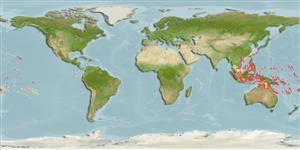>
Eupercaria/misc (Various families in series Eupercaria) >
Labridae (Wrasses) > Corinae
Etymology: Halichoeres: Greek, als, alis = salt + Greek, choiros = pig (Ref. 45335).
More on author: Bleeker.
Environment: milieu / climate zone / depth range / distribution range
Ecologia
marino associati a barriera corallina; distribuzione batimetrica 2 - 40 m (Ref. 9710). Tropical; 30°N - 24°S
Western Pacific: east to Samoa (Ref. 27362) and Tonga (Ref. 53797).
Size / Peso / Age
Maturity: Lm ? range ? - ? cm
Max length : 13.0 cm SL maschio/sesso non determinato; (Ref. 9823)
Spine dorsali (totale): 9; Raggi dorsali molli (totale): 12-13; Spine anali 3; Raggi anali molli: 12; Vertebre: 25. Anterior head and body color of adults in life bluish gray, shading posteriorly to yellowish; scales often with orange-yellow vertical lines; a dark spot posterior to dorsal half of eye; dorsal fin with a large black spot edged with blue. Anterior lateral line scales with 1-3 pores; 9-11 suborbital pores. Anterior dorsal and anal soft rays longer than posterior rays; pelvic fins of males and large females very long, reaching posterior to anus, often to or beyond origin of anal fin. Juveniles with 4 black stripes on head and body.
Inhabits lagoon and seaward reefs, in coral-rich areas (Ref. 9710). Also found along drop-offs on the bottom of large caves. Usually seen solitary (Ref. 48636).
Life cycle and mating behavior
Maturità | Riproduzione | Deposizione | Uova | Fecundity | Larve
Distinct pairing during breeding (Ref. 205).
Randall, J.E., G.R. Allen and R.C. Steene, 1990. Fishes of the Great Barrier Reef and Coral Sea. University of Hawaii Press, Honolulu, Hawaii. 506 p. (Ref. 2334)
IUCN Red List Status (Ref. 130435)
Threat to humans
Harmless
Human uses
Acquario: Commerciale
Informazioni ulteriori
BibliografiaAcquacolturaProfilo di acquacolturaVarietàGeneticaElectrophoresesEreditarietàMalattieElaborazioneNutrientsMass conversion
CollaboratoriImmaginiStamps, Coins Misc.SuoniCiguateraVelocitàModalità di nuotoArea branchialeOtolithsCervelliVista
Strumenti
Special reports
Download XML
Fonti Internet
Estimates based on models
Preferred temperature (Ref.
123201): 25.4 - 28.9, mean 27.7 °C (based on 332 cells).
Phylogenetic diversity index (Ref.
82804): PD
50 = 0.5000 [Uniqueness, from 0.5 = low to 2.0 = high].
Bayesian length-weight: a=0.00955 (0.00451 - 0.02020), b=3.09 (2.92 - 3.26), in cm total length, based on LWR estimates for this Genus-body shape (Ref.
93245).
Trophic level (Ref.
69278): 3.5 ±0.5 se; based on size and trophs of closest relatives
Resilienza (Ref.
120179): Alto, tempo minimo di raddoppiamento della popolazione meno di 15 mesi (Preliminary K or Fecundity.).
Fishing Vulnerability (Ref.
59153): Low vulnerability (10 of 100).
Nutrients (Ref.
124155): Calcium = 91.1 [53.6, 154.4] mg/100g; Iron = 0.73 [0.43, 1.35] mg/100g; Protein = 18.4 [15.5, 20.5] %; Omega3 = 0.164 [0.103, 0.259] g/100g; Selenium = 23.7 [14.0, 42.7] μg/100g; VitaminA = 162 [49, 598] μg/100g; Zinc = 1.8 [1.2, 2.9] mg/100g (wet weight);
